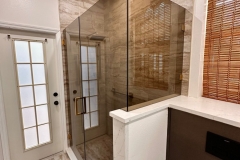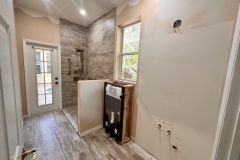Mirrored bathroom vanity Shore Acres:
Are you looking to revamp your bathroom space? Look no further than a stylish and functional bathroom sink. With various designs and materials available, you can easily find the perfect sink to complement your existing decor. Whether you prefer a sleek modern look or a classic and timeless design, a new sink will add both beauty and functionality to your bathroom. Explore our guide to choosing the ideal bathroom sink and get ready to transform your space.
Why choose a bathroom sink ?
While bathroom sinks are typically associated with the bathroom, they can bring a unique and contemporary touch to your kitchen. These sinks often feature sleek designs, modern materials, and innovative features that can add both style and functionality to your kitchen cabinets.
What are the benefits?
1. Aesthetics: A stylish bathroom sink can instantly elevate the overall design of your kitchen cabinets. Whether you prefer a minimalist look or a bold statement piece, there are various sink styles available to suit your taste.
2. Space-saving: Many bathroom sinks are designed to be compact, making them perfect for smaller kitchens or limited cabinet space. By choosing a bathroom sink for your kitchen cabinets, you can optimize the use of available space without compromising on style.
3. Practicality: Bathroom sinks often come with additional features such as built-in soap dispensers, cutting boards, or drying racks. These practical additions can make your kitchen more functional and efficient, allowing you to maximize the use of your cabinets.
How to incorporate a bathroom sink into your kitchen cabinets?
There are several ways to seamlessly integrate a bathroom sink into your kitchen cabinets:
1. Swap out your existing kitchen sink with a bathroom sink that fits the dimensions of your cabinet space.
2. Install a smaller bathroom sink alongside your primary kitchen sink. This can be especially useful if you have multiple cooks in the kitchen or need a designated area for food preparation.
3. Utilize a standalone bathroom sink as an additional feature in your kitchen island or peninsula. This can serve as a focal point and create a stylish and functional workspace.
Frequent Questions
What types of bathroom sinks are compatible with kitchen cabinets?
When it comes to bathroom sinks that are compatible with kitchen cabinets, it’s important to consider the style, size, and installation requirements. Here are a few types of bathroom sinks that can work well with kitchen cabinets:
1. Drop-in Sinks: These sinks have a rim that sits on top of the countertop, making them easy to install on most types of kitchen cabinets. They are available in various shapes and sizes to suit different design preferences.
2. Undermount Sinks: Undermount sinks are installed underneath the countertop, creating a seamless and modern look. They require a solid surface countertop material, such as granite or quartz, for proper installation.
3. Vessel Sinks: Vessel sinks sit on top of the countertop and are a popular choice for modern and contemporary designs. They can be paired with a compatible faucet mounted on the countertop or wall.
4. Wall-Mounted Sinks: Wall-mounted sinks are mounted directly onto the wall, without the need for a cabinet or countertop. They are a space-saving option and can create a minimalist aesthetic in the bathroom.
It’s crucial to measure and consider the dimensions of both the sink and the cabinet to ensure a proper fit. Additionally, consult with a professional installer to ensure the chosen sink is compatible with your kitchen cabinet design.
How do I choose the right size bathroom sink ?
To choose the right size bathroom sink , you need to consider the dimensions of both the cabinet and the sink.
1. Measure the cabinet:
Start by measuring the width and depth of your kitchen cabinet. These measurements will determine the maximum dimensions of the sink that can fit into the cabinet.
2. Consider the sink style:
Next, think about the style of sink you want. There are various options available, such as undermount, drop-in, vessel, or wall-mounted sinks. Each style has different installation requirements and may require specific measurements.
3. Allow for countertop space:
Remember to leave enough space on the countertop around the sink for functional use. Consider how much space you will need for activities like dishwashing or food preparation.
4. Check plumbing connections:
Ensure that the plumbing connections in the cabinet align with the new sink. Measure the location of the drain and supply lines to ensure they match up with the sink’s dimensions and placement.
5. Choose the right size sink:
Based on the measurements and style preferences, select a sink size that fits comfortably within the cabinet. Remember to account for the sink’s depth as well.
6. Consider additional features:
Lastly, consider any additional features you may want, such as extra basins, built-in soap dispensers, or garbage disposals. Ensure that these features are compatible with the chosen sink size and style.
By following these steps and considering your specific needs, you can select the right size bathroom sink for your kitchen cabinet.
Are there any specific design considerations to keep in mind when installing a bathroom sink ?
Size and Shape: Ensure that the cabinet is large enough to accommodate the chosen bathroom sink. Consider the overall dimensions, including width, depth, and height, to ensure a proper fit.
Plumbing Connections: The cabinet should have sufficient space and access points for plumbing connections. This may include provisions for drain lines, water supply lines, and other necessary fixtures.
Ventilation: Adequate ventilation is essential to prevent moisture buildup and ensure the longevity of the cabinet and sink. Consider incorporating vents or openings to promote air circulation and prevent the growth of mold and mildew.
Waterproofing: Since a bathroom sink produces water splashes, it is important to take measures to protect the kitchen cabinet from potential water damage. Apply a waterproof sealant or coating to the interior and exterior surfaces of the cabinet to provide added protection.
Accessibility: Consider how the bathroom sink installation will affect the accessibility of the cabinet. Ensure that drawers, shelves, or other storage areas are not obstructed and that users can easily reach items stored inside.
Aesthetics and Design Cohesion: The bathroom sink should blend well with the overall design and style of the cabinetry. Choose a sink that complements the cabinet’s color, finish, and materials to ensure visual harmony in the space.
By considering these design considerations, you can ensure a successful installation of a bathroom sink in a kitchen cabinet.
























